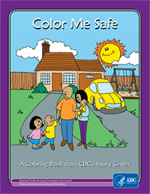A National Action Plan for Child Injury Prevention
Reducing Poisoning Injuries in Children
Download Print Version [321KB PDF]

Unintentional poisoning killed 824 U.S. children in 2009; 90 percent of them were teenagers. 128,000 children visited emergency departments for poisoning-related injuries in 2010; half of them were teens.1 Prescription drug misuse and abuse among teens has reached epidemic proportions and is now a serious public health threat. In 2010, more than 7% of young people 12-17 years old reported using prescription drugs for non-medical reasons in the past year.2 More concerning, the prescription drug death rate more than doubled among this age group from 1999-2008.1
In addition, U.S. poison centers received more than 1.6 million calls involving children 19 and younger in 2009. About 80 percent of these calls were for children under 5, and more than half of them involved exposures to medications.3
Most of these poisoning-related deaths and injuries are predictable and preventable.
A National Action Plan
The Centers for Disease Control and Prevention (CDC) is committed to preventing child injury by supporting solutions that will save lives. The National Action Plan for Child Injury Prevention (NAP) was developed by CDC and more than 60 stakeholders to spark action across the nation. The overall goals of the NAP are to raise awareness about the problem of child injury and its effects on our nation, offer solutions by uniting stakeholders around a common set of goals and strategies, and mobilize action to reduce child injury and death.
The NAP contains six domains that include goals and actions based on what we know, where we need to go, and how we can get there. See below for examples of what we can do to further reduce poisoning-related injuries among children.
Data and Surveillance—includes the ongoing and systematic collection, analysis, and interpretation of child health data for planning, implementing, and evaluating injury prevention efforts.
- Improve data systems such as prescription drug monitoring programs (PDMPs), health information exchanges, and prescription claims programs to enable identification of prescribing patterns for children and reasons why these drugs were prescribed.
- Use PDMPs to identify inappropriate prescribing of controlled prescription drugs to children. PDMPs already operate in 40 states. They can be improved by having all PDMPs share data between states, use real-time reporting, and conduct proactive reporting to providers.
Research—includes gaps in and priorities for risk factor identification, intervention, program evaluation, and dissemination strategies needed to reduce injuries.
- Conduct research on the fate of prescription drugs dispensed to adolescents. For example, determine if they are consumed for a medical reason, consumed for other reasons, given away, sold, or left unused.
- Estimate the impact of current medication disposal programs on the prevalence of unused drugs of abuse in the home that teens could divert to nonmedical use.
Communication—includes effective strategies to promote injury prevention to target audiences, through designing messages and information, and delivering them through relevant channels.
- Communicate to health care providers, patients, and caregivers about the lack of evidence that chronic use of opioids and psychotherapeutic drugs among children is beneficial.
- Encourage widespread use of public information campaigns such as CDC’s partnership with the “Up and Away” initiative. This educational program reminds families of the importance of safe medication storage. For more info, please visit http://www.upandaway.org.
Education and training—includes organized learning experiences for increasing knowledge, attitudes, and behavior change conducive to preventing injuries.
- Educate health care providers on the appropriate prescribing of controlled prescription drugs to minors to include proper dosages, quantities, and conditions for which these drugs’ benefits outweigh their risks.
- Educate health care providers on how to identify and address drug misuse and abuse in adolescents.
Health systems and health care—includes the health infrastructure required to deliver quality care and clinical and community preventive services.
- Create guidelines for prescribing controlled prescription drugs to children that can be implemented by health care systems and insurers.
- Leverage insurer and pharmacy benefit manager mechanisms to reduce the amount of unused medications available for diversion, abuse, and overdose.
Policy—includes laws, regulations, incentives, administrative actions, and voluntary practices that enable safer environments and decision making.
- Improve access of law enforcement agencies to data from state prescription drug monitoring programs to help identify “pill mills,” which flood communities with prescription drugs prone to abuse. Such drugs often wind up in the hands of adolescents.
- Better enforce FDA regulations prohibiting the marketing to providers of off-label uses of psychotherapeutic drugs, e.g., sleep aids, in children.
Moving Forward Together
Everyone—including parents, health care providers, educators, and community members—can take steps to prevent injury where they live, work, and play. We all have a part to play in the NAP and in protecting our children—America’s future.
References
-
Centers for Disease Control and Prevention. WONDER [Online]. (2012) Centers for Disease Control and Prevention (producer). 2012 [cited 2012 April 8]; Available from: http://wonder.cdc.gov.
-
Substance Abuse and Mental Health Services Administration, Results from the 2010 National Survey on Drug Use and Health: Detailed tables, in NSDUH Series H-412011, Substance Abuse and Mental Health Services Administration, Center for Behavioral Health Statistics and Quality: Rockville, MD.
-
Bronstein, A., et al., 2009 annual report of the American Association of Poison Control Centers' National Poison Data System (NPDS): 27th annual report. Clinical Toxicology, 2010. 48: p. 979-1178.
Get email updates
To receive email updates about this page, enter your email address:
Contact Us:
- Centers for Disease Control and Prevention
National Center for Injury Prevention and Control (NCIPC)
4770 Buford Hwy, NE
MS F-63
Atlanta, GA 30341-3717 - 800-CDC-INFO
(800-232-4636)
TTY: (888) 232-6348
New Hours of Operation:
8am-8pm ET/
Monday-Friday
Closed Holidays - cdcinfo@cdc.gov





